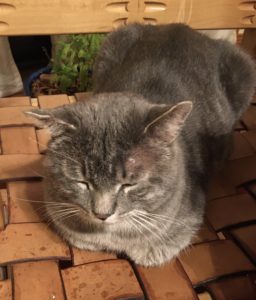Why do cats purr? What does a purr mean? I would say that most of us think of a purring cat as contented. I wondered if there was more to the purr – my ex-street cat, Gus, does not seem to purr at all.

How cats purr
Purring seems effortless. People who study purring say that the opening and closing of the vocal folds (vocal cords) in the cat’s larynx while he breathes in and out produces the sound we call “purring”.
Purring is different from other vocalizations such as meowing because it occurs not only when the cat breathes out, but also when he breathes in. Meowing, hissing, chirping, for example, occur only on expiration, when breathing out.
Purring is a low frequency sound (25-150 Hz) and does not vary much in frequency. Vocalizations like the meow are higher frequency sounds. They are generated by vibrations of the vocal folds in the larynx. Changes in the tension (length) of the vocal folds produce sounds with a range of several octaves at frequencies exceeding 100 Hz.
The cat can control the separation of his vocal folds independently of their length (or tension). So the cat can purr while he is meowing!
the cats that roar and the cats that purr
Around 1916, Reginald Innes Pocock divided the cat family into the “cats that roar” (lion, tiger, jaguar, leopards) and the “cats that purr” (domestic cats, cheetahs). This classification was based on the anatomy of the hyoid bone, a u-shaped bone in the neck that supports the tongue. Currently, the hyoid bone is not thought to determine whether or not a cat can purr (indeed, snow leopards can purr). The classification of cat species is now based on molecular characteristics, eg. DNA.
when cats purr
So, cats purr as they breathe in and out and their vocal folds open and close. When do they purr?
Feline guru John Bradshaw notes that cats may purr:
- when being groomed by another cat
- a cat may purr while grooming himself
- kittens purr while nursing and often their mother joins in
- some cats purr when they are just walking around
- when greeting a friendly cat
- when in contact with another cat
Purring is not particularly loud (when compared with a howl!) and is heard over short distances; it most likely originated as a sound made by kittens, to induce their mother to feed them. Purring kittens with mama cat is the ultimate picture of contentment!
the healing purr
Cats are know to purr when they are in pain or anxious, for example, at the veterinary clinic. The purr ranges in frequency from 25 – 150 Hz. The purr of domestic cats, servals, ocelots, and pumas produce strong frequencies at 25 Hz, 50 Hz and 100 Hz.
In human medicine, the application of low frequency vibrations (25-50 Hz) has been found to inhibit bone loss and initiate bone repair. Frequencies around 100 Hz are used to treat pain, swelling, and wounds .
Are cats able to heal themselves by purring ? Is purring a “feel good” (self-soothing) behavior? (So why isn’t Gus purring?)
The “solicitation purr”
Earlier, we noted that a cat can vocalize and purr at the same time. Cats have taken advantage of this and have developed a “solicitation purr”, one that has a meow embedded in the purr. Cats have discovered how to use this to alert their owners to their needs, like “I want food”.
Acoustical analysis of the “solicitation purr” shows a peak around 380 Hz in the purr spectra. This frequency is more typical of a cry or meow, not the low frequency purr and is close to the frequency of a human infant’s cry (300–600Hz)
This cry gives the “solicitation purr” its urgency that drives us to attend to the cat, giving her head rubs, food or whatever else we think she needs. It taps into our inborn sensitivity to the cries of infants, making it hard to ignore.
The purr is a lot more than the sound of a contented cat. It can also be a greeting, a self-soothing behavior or healing mechanism, or a request for someone to do something for the cat. It is a quiet sound so make sure you don’t miss it!
And back to Gus, maybe that rumbly sound in his meows when he rubs against my legs are “solicitation purrs”. I will keep listening!
Want to keep up with the world of cats? Join The Feline Purrspective!

